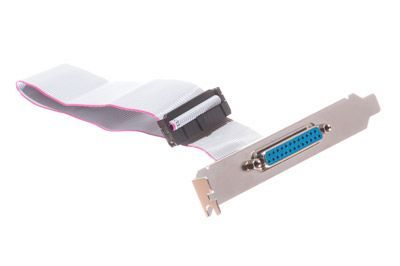DB25 Female to IDE 26 Pin Parallel Port Serial Cable - 1 FT
This product has been discontinued
Serial Computer Cables - 1FT DB25 Female to IDC 26 Pin Cable
This adapter cable connects to the motherboard or I/O adapter via flat ribbon cabling. Compatible with most brands of motherboards and I/O cards. The 12-inch length exceeds the standard length of cables, and provides flexibility for your connection.
Features:
- Connector A: DB25 Female
- Connector B: IDC 26 Pin
- 12 inch
- Includes bracket
Q: What is a null modem cable?
A: A null modem cable connects to two standard serial ports for networking two computers together. Null modem cables enable direct data transfer with minimum setup. Null modem cables reverse the transmit and receive lines on each end of the cable to enable direct two-way communication. A null modem cable for PCs ordinarily follows the RS-232 standard and uses the same serial ports as RS-232 cables.
Q: What is the difference between a DB15 and HD15 connector?
A: A DB15 connector has 15 pins arranged in two rows with one row on top of the other. The top row has 8 pins and the lower row has 7. A DB15 connector can be found on sound cards older AUI network cards and devices as well as legacy Macintosh® monitors.
A: An HD15 connector has 15 pins arranged in three rows. Each row has 5 pins with the middle row slightly offset from the top and bottom. A HD15 connector is sometimes called HD DB15 or VGA connector. The HD15 connector is a very common connector used mostly as a video interface for computers and monitors. It can also be found on HD displays and on older HD source devices such as satellite receivers and cable boxes.
What is a Parallel Cable?
A: A parallel cable is used to connect to the parallel ports on a computer and a peripheral device like a printer or external drive. IBM originally developed parallel ports and cables as a mean for connecting a printer to the earliest personal computers.

